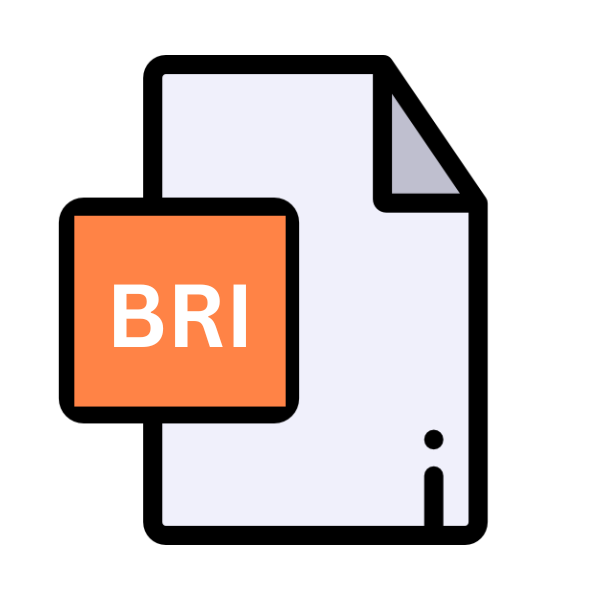.BRI File Extension

Bryce Plug-in File
| Developer | DAZ Productions |
| Popularity | |
| Category | Plugin Files |
| Format | .BRI |
| Cross Platform | Update Soon |
What is an BRI file?
the .BRM file extension might not be the most familiar one to many users. However, for enthusiasts of 3D modeling and rendering, particularly those who have delved into the realm of Bryce, this file format holds significant importance.
.The .BRM file extension is primarily associated with Bryce plug-in files, serving as containers for additional functionalities within the Bryce 3D modeling software.
More Information.
In the early stages of Bryce’s development, plug-ins were introduced as a means to enhance the software’s capabilities beyond its core features.
These plug-ins catered to various needs of users, ranging from additional rendering effects to advanced modeling tools.
The .BRM file extension was introduced as a container format specifically tailored to encapsulate these plug-ins, allowing for seamless integration into the Bryce ecosystem.
Origin Of This File.
The .BRM file extension emerged as an integral part of the Bryce software suite, which was developed by MetaCreations and later acquired by DAZ 3D. Bryce, renowned for its capabilities in landscape creation and realistic rendering, introduced plug-ins to extend its functionalities.
These plug-ins were encapsulated within .BRM files, enabling users to augment their creative endeavors within the Bryce environment.
File Structure Technical Specification.
The .BRM file format follows a structured layout optimized for compatibility with Bryce. While specific details regarding its internal structure may vary depending on the complexity of the plug-in it contains.
.BRM files typically include metadata, resource references, and executable code necessary for the plug-in to function within the Bryce environment.
From a technical standpoint, .BRM files are often encoded in a proprietary format optimized for efficient parsing and execution within Bryce.
How to Convert the File?
Converting .BRM files can be a bit tricky due to their proprietary nature and association with the Bryce software ecosystem.
Since direct conversion methods may not be readily available, alternative approaches are often necessary. Here’s a guide on how to convert .BRM files:
- Export from Bryce: One of the most straightforward methods is to utilize the export functionality within the Bryce software itself. Bryce supports various file formats for exporting projects, including common formats like .OBJ (Wavefront), .3DS (3D Studio), or .DAZ (DAZ Studio). By exporting your Bryce project to one of these compatible formats, you can effectively convert your .BRM file into a more universally recognized format that can be used in other 3D modeling and rendering software.
- Third-Party Conversion Tools: While direct conversion tools are specifically tailored for .BRM files may not be readily available, some third-party software solutions offer broader support for converting between different 3D file formats. Tools like Blender, Autodesk Maya, or Maxon Cinema 4D are capable of importing various file formats, including those commonly used in Bryce, and then exporting them to different formats as needed. By importing your .BRM file into one of these software packages and then exporting it to your desired format, you can achieve conversion indirectly.
- Online Conversion Services: There are online services and platforms available that offer file conversion services for various formats, including some commonly used in 3D modeling and rendering. While the availability of specific converters for .BRM files may be limited, you can explore general-purpose converters that support formats like .OBJ, .3DS, or .DAZ. Simply upload your .BRM file to the chosen online service, select your desired output format, and initiate the conversion process. Be cautious when using online converters and ensure that you trust the platform with your files, especially if they contain sensitive or proprietary information.
- Intermediary Formats: In some cases, it may be necessary to use an intermediary format as a bridge between .BRM and your desired output format. For example, you could export your .BRM file from Bryce to a format like .OBJ, which is widely supported across different 3D software packages. Once you have your file in the intermediary format, you can then import it into your chosen software and export it to the final desired format.
- Bryce Plug-in Conversion: If the .BRM file contains specific plug-ins or assets that you wish to use outside of the Bryce environment, you may need to explore options for extracting or converting these assets individually. This process may involve decompiling or reverse-engineering the plug-in to access its components, which can be complex and may require technical expertise.
Advantages And Disadvantages.
Advantage:
- Enhanced Functionality: .BRM files empower users with the ability to expand Bryce’s capabilities through third-party plug-ins, thereby unlocking new avenues for creative expression.
- Customization: By supporting plug-ins encapsulated within .BRM files, Bryce fosters a vibrant ecosystem of custom tools and effects tailored to the diverse needs of its user base.
- Community Collaboration: The availability of .BRM plug-ins encourage collaboration and knowledge-sharing within the Bryce community, fostering innovation and the exchange of creative ideas.
Disadvantage:
- Compatibility Limitations: .BRM files are inherently tied to the Bryce software ecosystem, limiting their compatibility with other 3D modeling and rendering platforms.
- Dependency on Bryce: Users reliant on .BRM plug-ins are tethered to the Bryce software for utilizing these additional functionalities, which may pose challenges in interoperability with other software tools.
- Risk of Obsolescence: Given the proprietary nature of .BRM files and their association with a specific software package, there exists a risk of obsolescence if support for Bryce or .BRM plug-ins diminish over time.
How to Open BRI?
Open In Windows
Bryce Software: The most straightforward method to open .BRM files on Windows is by using the Bryce software itself.
Simply launch Bryce, go to the File menu, and select “Open” to browse for the .BRM file you want to open.
Open In Linux
Wine: Linux users can try running the Windows version of Bryce using Wine, a compatibility layer that allows running Windows applications on Linux.
Install Wine, then download and install the Windows version of Bryce. Once installed, follow the same steps as opening .BRM files in Windows.
Open In MAC
Bryce Software: If you’re using a Mac, you can open .BRM files by running the Bryce software, which is compatible with macOS. Launch Bryce, go to the File menu, and select “Open” to locate and open your .BRM file.
Open In Android
Conversion: Since Bryce software is not available for Android, opening .BRM files directly on an Android device isn’t possible.
You can convert .BRM files to a compatible format using a desktop computer or online conversion tool, then transfer the converted file to your Android device for viewing or further editing using compatible 3D modeling apps.
Open In IOS
Conversion: Similar to Android, there’s no native support for opening .BRM files on iOS devices. You’ll need to convert the .BRM file to a compatible format using a desktop computer or online conversion tool.
Once converted, you can transfer the file to your iOS device and use a compatible 3D modeling app to open and view it.
Open in Others
- Virtualization or Emulation: For operating systems not covered above, such as BSD variants or niche platforms, you may try using virtualization software like VirtualBox or emulation software like QEMU to run a compatible version of Windows or Linux. Install Bryce within the virtualized or emulated environment and follow the same steps as opening .BRM files on Windows or Linux.
- Conversion: If virtualization or emulation isn’t feasible, you can convert .BRM files to compatible formats using a desktop computer or online conversion tool. Once converted, you can use software compatible with the respective operating system to open and view the converted file.













